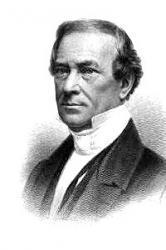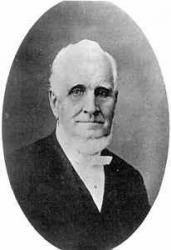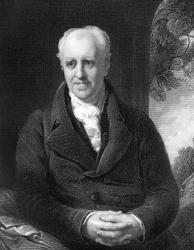Planning worship?
Check out our sister site, ZeteoSearch.org,
for 20+ additional resources related to your search.
- |
User Links
Person Results
‹ Return to hymnal




Export as CSV
Johann Gaudenz von Salis-Seewis

1762 - 1834 Person Name: J. G. von Salis-Seewis Hymnal Number: d436 Author of "Into the spirit land" in The Saints' Harp Salis-Seewis, Johann Gaudenz, Baron von, was born Dec. 26, 1762, at the castle of Bodmer (Bothmar), near Malans, Grisons, Switzerland. From 1779 to 1792 he was an officer in the French army; and after 1798 he held various offices connected with the Swiss Militia, and with his native canton. He died at Bodmer, Jan. 29, 1834, and was buried at Seewis, near Malans (Allg. Deutsche Biog., xxx., 245, &c). His Poems appeared as his Gedichte at Zurich, 1793; 2nd ed., 1794; 3rd, 1797; 4th, 1800; 4th enlarged ed., 1803; new ed., 1808 [all in Berlin Library], and many later eds. The most famous of his poems is "Das Grab ist tief und stille" (in his Gedichte, 1793, p. 35, entitled "The Grave, 1783"), of which there are at least 7 translations into English. The only one in English common use as a hymn is:—
Ins stille Land! Wer leitet uns hinüber. For the Dying. 1st published in his Gedichte, Neue Auflage, Zürich, 1808, p. 146, in 3 stanzas of 7 lines, each ending "Ins stille Land." In his Gedichte, Cologne, 1815, p. 134. The translation in common use is:—
Into the Silent Land! Ah! who shall lead us thither. In full by H. W. Longfellow in his Voices of the Night, Cambridge, U. S., 1840, p. 141, repeated in the later eds. of his Poetical Works. Included in Hedge and Huntington's Hymnsfor the Church of Christ, 1853, and many later American collections. It has been retranslated into Greek verse by Dr. B. H. Kennedy, in his Between Whiles, 1877. There are at least three other versions in English. [Rev. James Mearns, M.A.]
--John Julian, Dictionary of Hymnology, Appendix, Part II (1907)
Johann Gaudenz von Salis-Seewis
Edward Partridge
1793 - 1840 Hymnal Number: d488 Author of "Let Zion in her beauty rise" in The Saints' Harp
Edward Partridge
Andrews Norton
1786 - 1853 Hymnal Number: d562 Author of "My God, I thank thee, may no thought" in The Saints' Harp Norton, Andrews, D.D., son of Samuel Norton, was born at Higham, Massachusetts, Dec. 31, 1786, and was educated at Higham, and at Harvard College. After being engaged there for a short time as a tutor, he was appointed Librarian, and subsequently Lecturer on Biblical Criticism, as successor to Dr. Channing. When the Theological School was opened in 1819 he became Dexter Professor of Literature. This position he held until 1830. He died at Newport, Rhode Island, Sept. 18, 1853. He was for some time editor of the General Repository and Review, and published several prose works, one of the most extensive being The Genuineness of the Gospels, in 4 volumes. His hymns are few in number, and are mainly meditations in verse. They were contributed to various periodicals, and after his death were collected and published in a small volume. Of these hymns the following are in common use:--
1. Another year, another year, The unceasing rush, &c. Close of the Year. Appeared in the Christian Examiner in Nov. and Dec. 1827, in 11 stanzas of 4 lines. It is used in an abbreviated form. In the American Boston Unitarian Hymns [&Tune] Book, 1868, it begins with st. vi., "O what concerns it him whose way."
2. Faint not, poor traveller, though thy way. Fortitude. Printed in the Christian Disciple, July and Aug., 1822, in 7 st. of 4 1., and again in the West Boston Collection, 1823.
3. He has gone to his God, he has gone to his home. Burial. Printed in the Christian Examiner, Jan. and Feb., 1824.
4. My God, I thank Thee! may no thought. Trust and Submission. Appeared in the Monthly Anthology and Boston Review, Sept., 1809. This is his earliest and best known hymn.
5. 0 stay thy tears:for they are blest. Burial of the Young. Printed in the General Repository and Review, April, 1812, in 5 st. of 4 1. In 1855, st. iii.-v. were given in Beecher's Plymouth Collection, No. 1094, as "How blest are they whose transient years."
6. Where ancient forests round us spread. Dedication of a Church. This "Hymn for the Dedication of a Church," is dated 1833.
These hymns are in some of the American hymnals. Nos. 1, 4, 5 are in Martineau's Hymns, 1873, and the full texts of all are in Putnam's Singers and Songs of the Liberal Faith, Boston, U.S.A., 1875. [Rev. F. M. Bird, M.A.]
--John Julian, Dictionary of Hymnology (1907)
Andrews Norton
N. L. Frothingham

1793 - 1870 Person Name: Nathaniel Langdon Frothingham Hymnal Number: d597 Author of "O God, whose presence glows in all Within, around us, and above" in The Saints' Harp Frothingham, Nathaniel Langdon, D.D., born at Boston July 23rd, 1793, and graduated at Harvard 1811, where he was also sometime Tutor. From 1815 to 1850 he was Pastor of the First Church (Unitarian), Boston, and subsequently attended as a worshipper the church where he had been 35 years minister till his sight and strength failed him. He died April 4th, 1870.
His Metrical Pieces, in 2 volumes, were published in 1855 and 1870.
1. O God, Whose presence glows in all. Ordination. This was written in 1828 for the ordination of W. B. Lunt, New York.
2. We meditate the day . Installation. Written in 1835 for Mr. Lunt's installation at Quincy, Mass., as Co-pastor with Peter Whitney.
3. O Lord of life and truth and grace . Ordination. Also a special hymn. It was composed for the ordination of H. W. Bellowes, New York, 1839. It is found in common with Nos. 1 and 2 in Frothingham's Metrical Pieces, 1855. These Metrical Pieces are unknown to the English Collections. [Rev. F. M. Bird, M.A.]
--John Julian, Dictionary of Hymnology (1907)
================
Frothingham, N. L. , p. 400, ii. Other hymns are:—
1. O Saviour, Whose immortal word. Opening of a Place of Worship. Written "For the Dedication of the Church of the Saviour, Boston, November 16, 1847."
2. Remember Me, the Saviour said. Holy Communion.
3. They passed away from sight. Death and Burial.
4. When I am weak, I'm strong. Spiritual Strength. Nos. l, 2, and 4 are from his Metrical Pieces, Translated and Original, 1855,
--John Julian, Dictionary of Hymnology, Appendix, Part II (1907)
N. L. Frothingham
John Taylor

1808 - 1887 Hymnal Number: d292 Author of "Go, ye messengers of glory" in The Saints' Harp b. 11-1-1808; d. 7-25-1887; third president of the Church of Jesus Christ of Latter-Day Saints
--Library of Congress Name Authority Record
John Taylor
David M. Moir
Hymnal Number: d241 Author of "Fare thee well, our [thou] fondly cherished" in The Saints' Harp Moir, David Macbeth, was born at Musselburgh, Jan. 5, 1798. After attending the medical classes in the University of Edinburgh, he settled down as a doctor in his native place. In June, 1851, he went to Dumfries to recruit, but died there, July 6, and was buried at Inveresk, Musselburgh, July 10, 1851. His poems, selected and edited, with a memoir, by Thomas Aird, were published in 1852, in 2 vols., as The Poetical Works of David Macbeth Moir. He marked his graver contributions to Blackwood's Magazine with the signature "Delta" or Δ and in the number for August, 1832, there appeared "Devotional Melodies by Delta." These were three in number:—
1. Return, once more return, O wanderer.
2. O who is like the Mighty One.
3. How pleasant is the opening year.
and seem to have been the only hymns suited for public worship that he ever wrote. [Rev. James Mearns, M.A.]
--John Julian, Dictionary of Hymnology (1907)
David M. Moir
Joseph Woodward
Hymnal Number: d298 Author of "God is marshaling his army" in The Saints' Harp
Joseph Woodward
George Crabbe

1754 - 1832 Hymnal Number: d677 Author of "Pilgrim, burdened with thy sin, Haste to Zion's" in The Saints' Harp Crabbe, George, LL.B., born at Aldborough, Suffolk, Dec. 24, 1754, and educated for the medical profession, but after practising for a short time, he turned his attention to literature, and subsequently took Holy Orders. He was successively Curate of Aldborough and of Stathern, and Incumbent of Evershot, Mirston and Trowbridge. Died at Trowbridge, Feb. 3, 1832. He received his degree from the Archbishop of Canterbury.
Although well known as a poet, his hymns are very few, and but little known. His works include The Village; The Parish Register, 1807; and others. From The Parish Register, his hymn, "Pilgrim, burdened with thy sin" (q.v.) is taken. Crabbe's collected Works were published, with a Memoir, by his son, in 1834.
--John Julian, Dictionary of Hymnology (1907)
George Crabbe
G. W. Langford
Person Name: George W. Hangford Hymnal Number: d773 Author of "Speak gently, it is better far" in The Saints' Harp
G. W. Langford
William Russell
1798 - 1873 Hymnal Number: d646 Author of "O'er the dark wave [waves] of Galilee" in The Saints' Harp Russell, William, was born in Glasgow in 1798, and educated at the University of Glasgow. Removing from Scotland to America, he was at Savannah in 1817, and subsequently at other places in the United States. He was an active promoter of education, teachers' associations, and kindred objects, and did much to further the cause of education in the States. He was originally a Baptist, but did not hold to close communion. He died at Lancaster, Massachusetts, Aug. 16, 1873. His hymn, "O'er the dark wave of Galilee" (Christ in Solitude), begins with st. iii. of a poem written by him at the request of Dr. Ware, editor of the Unitarian Christian Examiner, and printed therein in 1826. [Rev. F. M. Bird, M.A.]
--John Julian, Dictionary of Hymnology (1907)
William Russell


 My Starred Hymns
My Starred Hymns


